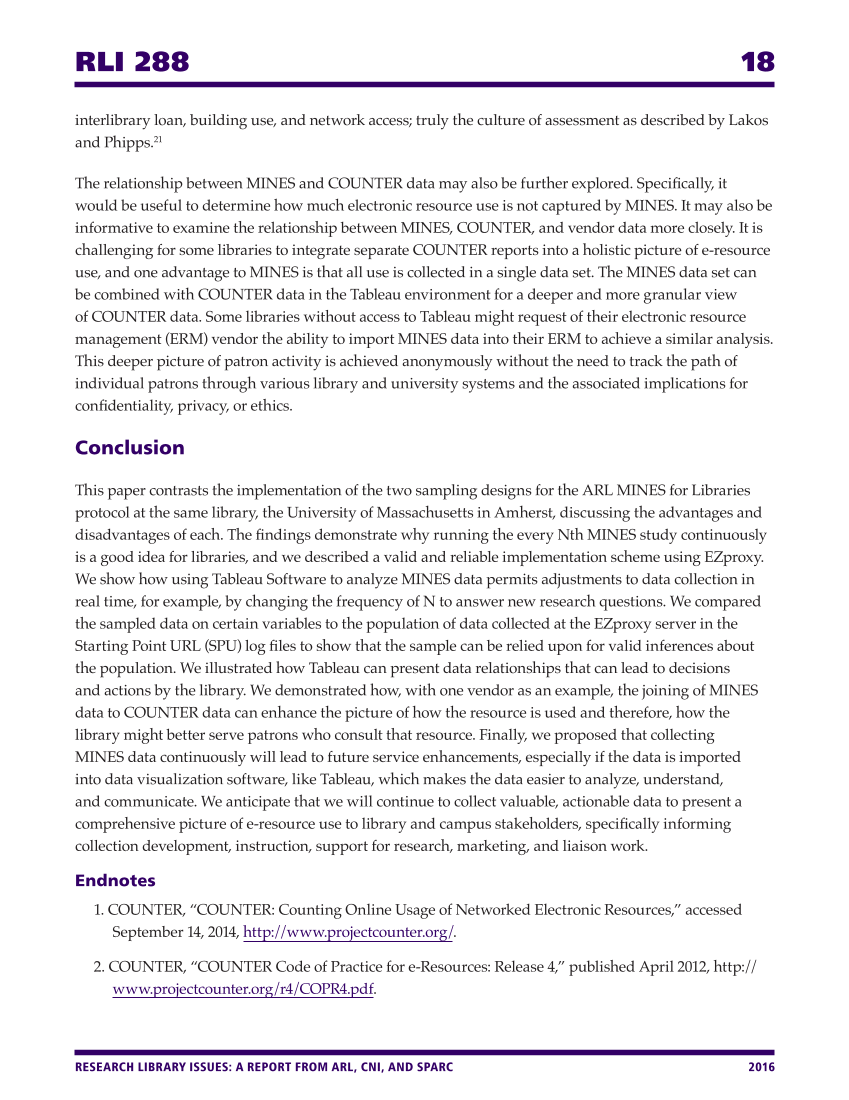RLI 288 18 RESEARCH LIBRARY ISSUES: A REPORT FROM ARL, CNI, AND SPARC 2016 interlibrary loan, building use, and network access truly the culture of assessment as described by Lakos and Phipps.21 The relationship between MINES and COUNTER data may also be further explored. Specifically, it would be useful to determine how much electronic resource use is not captured by MINES. It may also be informative to examine the relationship between MINES, COUNTER, and vendor data more closely. It is challenging for some libraries to integrate separate COUNTER reports into a holistic picture of e-resource use, and one advantage to MINES is that all use is collected in a single data set. The MINES data set can be combined with COUNTER data in the Tableau environment for a deeper and more granular view of COUNTER data. Some libraries without access to Tableau might request of their electronic resource management (ERM) vendor the ability to import MINES data into their ERM to achieve a similar analysis. This deeper picture of patron activity is achieved anonymously without the need to track the path of individual patrons through various library and university systems and the associated implications for confidentiality, privacy, or ethics. Conclusion This paper contrasts the implementation of the two sampling designs for the ARL MINES for Libraries protocol at the same library, the University of Massachusetts in Amherst, discussing the advantages and disadvantages of each. The findings demonstrate why running the every Nth MINES study continuously is a good idea for libraries, and we described a valid and reliable implementation scheme using EZproxy. We show how using Tableau Software to analyze MINES data permits adjustments to data collection in real time, for example, by changing the frequency of N to answer new research questions. We compared the sampled data on certain variables to the population of data collected at the EZproxy server in the Starting Point URL (SPU) log files to show that the sample can be relied upon for valid inferences about the population. We illustrated how Tableau can present data relationships that can lead to decisions and actions by the library. We demonstrated how, with one vendor as an example, the joining of MINES data to COUNTER data can enhance the picture of how the resource is used and therefore, how the library might better serve patrons who consult that resource. Finally, we proposed that collecting MINES data continuously will lead to future service enhancements, especially if the data is imported into data visualization software, like Tableau, which makes the data easier to analyze, understand, and communicate. We anticipate that we will continue to collect valuable, actionable data to present a comprehensive picture of e-resource use to library and campus stakeholders, specifically informing collection development, instruction, support for research, marketing, and liaison work. Endnotes 1. COUNTER, “COUNTER: Counting Online Usage of Networked Electronic Resources,” accessed September 14, 2014, http://www.projectcounter.org/. 2. COUNTER, “COUNTER Code of Practice for e-Resources: Release 4,” published April 2012, http:// www.projectcounter.org/r4/COPR4.pdf.





































